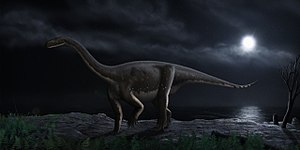Melanorosauridae
| Melanorosauridae | ||||||||||||
|---|---|---|---|---|---|---|---|---|---|---|---|---|

Live reconstruction of Melanorosaurus , the eponymous genus |
||||||||||||
| Temporal occurrence | ||||||||||||
| Upper Triassic ( Norium to Rhaetium ) | ||||||||||||
| 228 to 201.3 million years | ||||||||||||
| Locations | ||||||||||||
| Systematics | ||||||||||||
|
||||||||||||
| Scientific name | ||||||||||||
| Melanorosauridae | ||||||||||||
| von Huene , 1929 |
The Melanorosauridae is a group of sauropodomorphic dinosaurs first proposed by Friedrich von Huene in 1929 . According to a study by Galton and Upchurch (2004), this group includes the genera Melanorosaurus , Riojasaurus , Camelotia and Lessemsaurus . According to this classification, the Melanorosauridae would have been distributed over the areas of today's Argentina, England and South Africa during the Upper Triassic ( Norium to Rhaetium ). The validity of the group is disputed, so the relationships between the included genera are little known.
Definition, genres and validity
Galton and Upchurch (2004) define the Melanorosauridae as any taxa more closely related to Melanorosaurus than to Anchisaurus . Galton and Upchurch attribute the genera Melanorosaurus , Riojasaurus , Lessemsaurus and Camelotia to the group. Benton (1993) also attributed the Lufengosaurus from the Lower Jurassic of China to the group, but this is not supported by later studies.
The validity of the group is controversial, so the name Melanorosauridae is not used by many studies. Sereno (2005) considers the group to be invalid, the group is not well supported by cladistic analyzes, and an adequate definition of the group is not possible. However, Galton and Upchurch 1990, 2004, and Barrett and Upchurch (2005) consider the Melanorosauridae to be a valid, monophyletic group.
features
Galton and Upchurch (2004) give various jointly derived characteristics (synapomorphies) by means of which the group should be distinguished from other groups. These features include a dorso-sacral vertebra that is also attached to the sacrum; A step-like, S-shaped dorsal edge of the ilium as well as various features of the thigh bone (femur) - for example, the femur shaft is widened when viewed from behind (cranio-caudal) and narrower when viewed from the side.
External system
Galton and Upchurch (2004) combine the Melanorosauridae and the Anchisauridae within a new group that they call Anchisauria . This group is said to be more closely related to the sauropods than most of the other genera of earlier sauropodomorpha such as Plateosaurus or Massospondylus , traditionally referred to as prosauropods .
Individual evidence
- ^ Gregory S. Paul : The Princeton Field Guide To Dinosaurs. Princeton University Press, Princeton NJ et al. 2010, ISBN 978-0-691-13720-9 , pp. 170-171, online .
- ↑ Friedrich von Huene : Brief overview of the Saurischia and their natural connections. In: Paleontological Journal. Vol. 11, No. 3, 1929, ISSN 0031-0220 , pp. 269-273, doi : 10.1007 / BF03042732 .
- ↑ a b c d e f Peter Galton , Paul Upchurch : Prosauropoda. In: David B. Weishampel , Peter Dodson , Halszka Osmólska (eds.): The Dinosauria . 2nd edition. University of California Press, Berkeley CA et al. 2004, ISBN 0-520-24209-2 , pp. 232-258.
- ^ A b c Paul M. Barrett , Paul Upchurch: Sauropodomorph Diversity through Time: Paleoecological and Macro Evolutionary Implications. In: Kristina Curry A. Rogers, Jeffrey A. Wilson (Eds.): The Sauropods. Evolution and Paleobiology. University of California Press, Berkeley CA et al. 2005, ISBN 0-520-24623-3 , pp. 125-156, doi : 10.1525 / california / 9780520246232.003.0005 .
- ↑ a b Paul Sereno : Melanorosauridae. (No longer available online.) In: Taxon Search. Archived from the original on August 9, 2014 ; Retrieved August 9, 2014 . Info: The archive link was inserted automatically and has not yet been checked. Please check the original and archive link according to the instructions and then remove this notice.
Web links
- Melanorosauridae in The Paleobiology Database